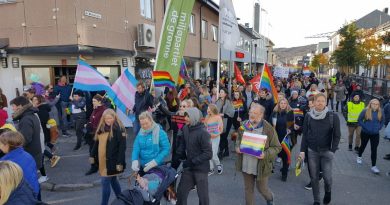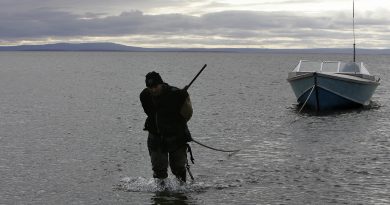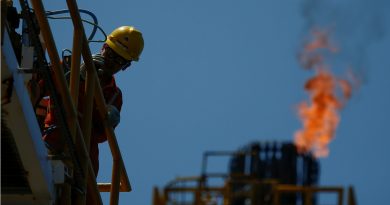Blog: COP28 was bad news for the world’s ice & those whose future depends on it
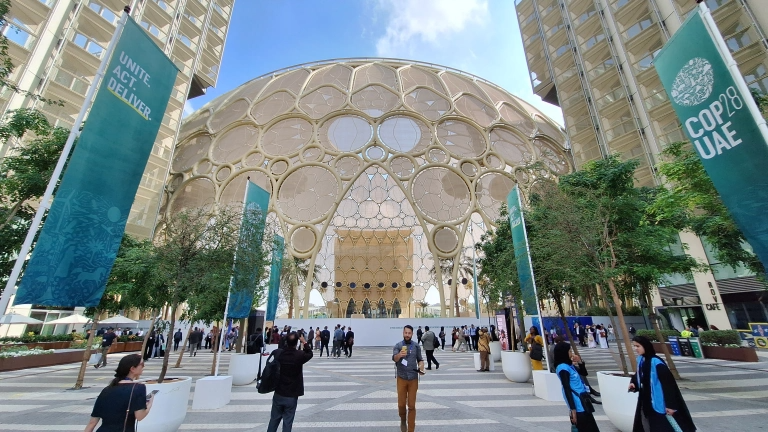
I went to Dubai for the UN Climate Conference COP28 with mixed feelings.
On the one hand, the controversy over the location and the President, head of a giant fossil fuel concern, made me somewhat sceptical. On the other, I was driven by the awareness that this was a kind of last chance, with the world in the grip of extreme climate events and the window of opportunity closing rapidly. Could the active participation of the fossil fuels lobby bring about the rapid action, the switch to renewables, the swift drop in emissions we need to safeguard the frozen parts of the Earth and limit the catastrophic impacts of a melting cryosphere on low-lying nations and high mountain communities all round the globe?
Phase down fossil fuels – would this year’s gathering finally opt for the “phase-out” that could limit global warming to 1.5°C and give us a fighting chance of slowing down impacts, catching up with adaptation and coping with loss and damage? Surely the “Global Stocktake”, GST could only lead to that logical conclusion?
Phase out, phase down… transition away
After observing the usual frantic last-minute wrangling to come up with a closing text, my scepticism was justified. The deal was hailed as historic as it was the first time fossil fuels, the root cause of the climate crisis, had been cited in some 30 years of climate negotiations. Unbelievable as that may seem. However, the economic interests of the petrostates prevented anything more than acknowledgement of a vague “transition away” from fossil fuels. I’m afraid I can’t share the widespread (at least some people are doing their damndest to spread it widely) optimism that this was a historic turning point, the beginning of better times. The term “phase-out” had been backed by 130 of the 198 countries negotiating in Dubai but was blocked by fossil fuel countries including Saudi Arabia. In fact, the COP28 President Sultan al Jaber has since clearly stated his intention to keep selling fossil fuels as long as anybody wants to buy them. (Of course there are always two sides to a deal).
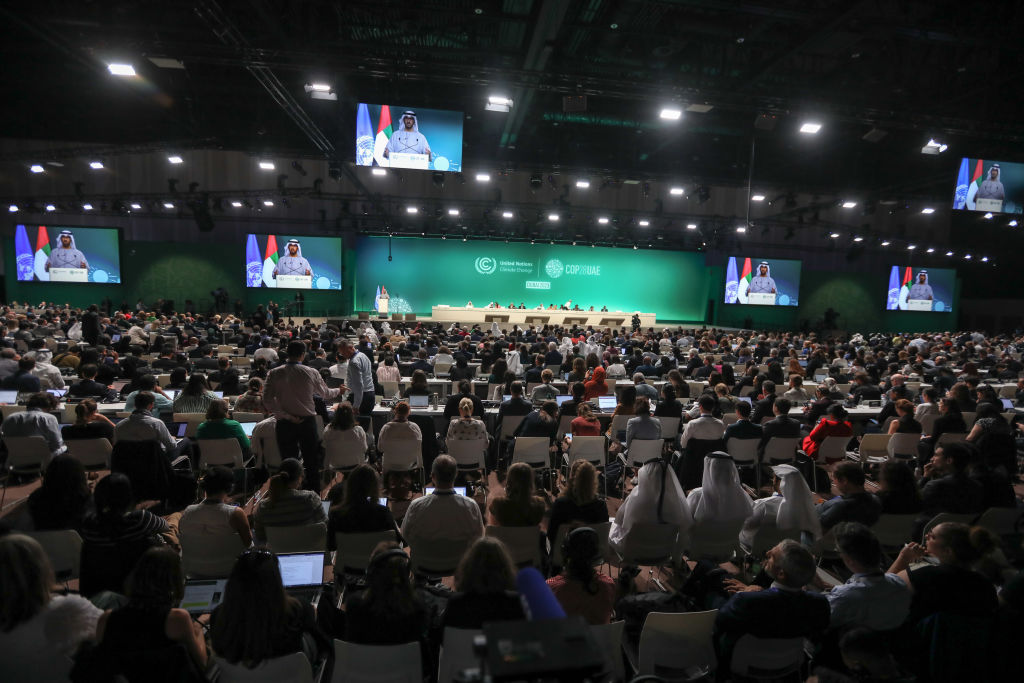
In the words of Eric Rignot, Distinguished Professor of Earth System Science at the University of California, Irvine: “What was decided at COP28 is not a small step forward. Not at all. It is totally unfair to minorities, poor populations, young people across the world, and globally to all the people who benefit the least from fossil fuel emissions but are (not will be) first in line to be affected by the impacts. Science is not being heard and scientists need to point out the real science far more strongly than we currently do.”
Well, the ice scientists I have been working with and listening to before and during COP28 were certainly going all out to put their message across: 2°C is too high for the cryosphere: our ice sheets, glaciers, sea ice, permafrost. 1.5°C would be the absolute upper limit – and still too high, according to some. To stay there, we would have to phase out fossil fuels asap.
There was no shortage of scientific advice on offer in Dubai. The International Cryosphere Climate Initiative had a dedicated “Cryosphere Pavilion” offering exhibitions and back-to-back talks and presentations. (Now available to watch online as they were all live-streamed). The cryosphere, ice and snow, polar regions, Himalayas, glaciers, polar oceans all featured in numerous events elsewhere. At an event in the Chile Pavilion, I heard the outraged public reactions of glaciologists, oceanographers, ice sheet modellers, to the controversial statement by the COP President that was publicised early in the proceedings claiming that there was no science to back up the call for a phase-out of fossil fuels.
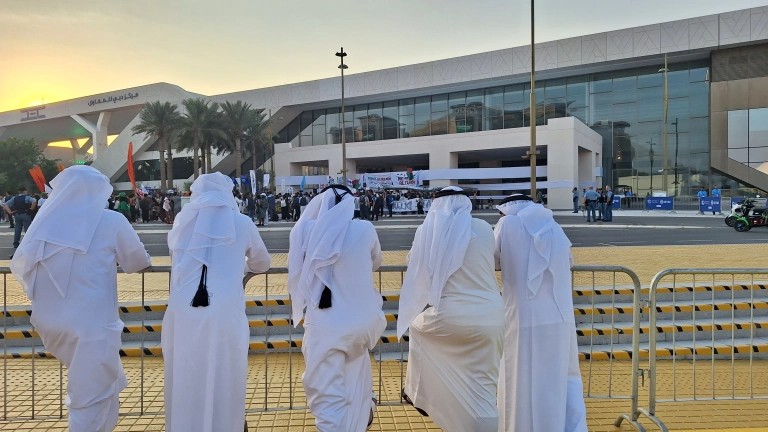
Interest in ice hotting up
There had been an upsurge in interest in the polar regions and the ice-topped mountains of the planet in the months leading up to this key climate meeting.
Cryosphere scientists at the Bonn UN Climate Change Conference in June sounded the alarm at the speed and scale of ice-melt worldwide, which is far outpacing worst-case scenario projections from the IPCC .
A report published by ICIMOD Water, ice, society, and ecosystems in the Hindu Kush Himalaya (HI-WISE) showed that glaciers there disappeared 65% faster in 2011–2020 compared with the previous decade. The experts warned policymakers of the need to prepare for the “cascading impacts of climate change, which will affect a quarter of the world’s population”.

In November, France staged a highest-level Polar Summit, where scientists published a “Call for Glaciers”. Paris signed up to the Ambition on Melting Ice (AMI) high-level group on Sea-level Rise and Mountain Water Resources, founded by 20 government ministers at COP27 in Sharm El-Sheikh, Egypt. AMI aims to ensure that the irreversible and devastating global impacts of cryosphere loss are understood by political leaders and the public alike: not only within mountain and polar regions, but throughout the planet.
Just ahead of the Dubai meeting, The State of the Cryosphere 2023 – Two Degrees is Too High report showed that just 2°C of global warming will trigger irreversible loss to Earth’s ice sheets, mountain glaciers and snow, sea ice, permafrost, and polar oceans, with disastrous consequences for millions of people, societies, and nature.
The UN Secretary-General Antonio Guterres visited the Himalayas and the Antarctic in the weeks before COP28, experiencing at first hand how the iciest parts of the planet are being affected by human-induced climate change. “Glaciers are retreating: we cannot,” he said. He referrred to this many times during the Dubai conference.
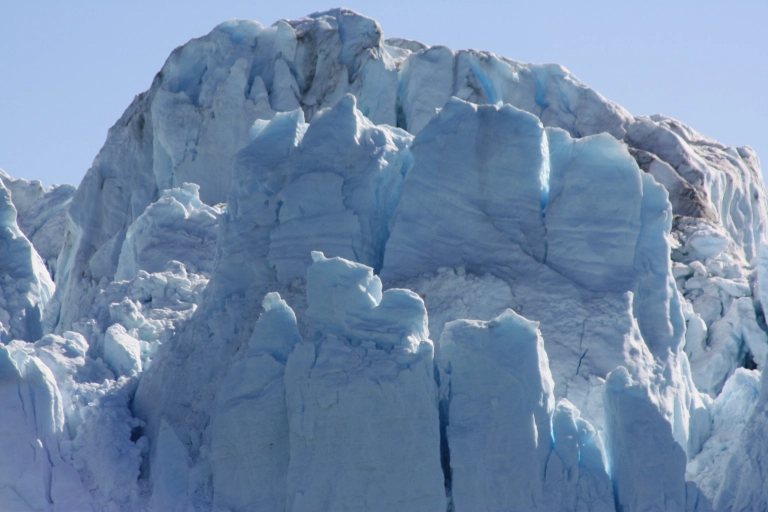
Insanity to ignore the science
A “Cryosphere Call to Action” from scientists reached 1,000 signatures as the COP drew to its underwhelming conclusion.
“This has been a year of climate disasters and ice loss. A glacial lake outburst flood devastated Sikkim in India. Swiss glaciers lost 10% of their remaining ice over just two years. Sea ice around Antarctica hit all-time-low summer and winter records. Unprecedented fires raged across Canadian permafrost. Parts of the Arctic and North Atlantic saw water temperatures 4-6°C higher than normal. It rained far inland on Antarctica, and Greenland saw its second-highest surface melt ever.” – That is the background to the scientists’ appeal.
“The warming impact of CO2, around 80% from fossil fuel use, already has led to steep glacier and ice sheet loss causing global sea-level rise; reduction of water resources from snowpack; growing CO2 and methane emissions from thawing permafrost; dramatic reduction of sea ice, now alarmingly low in both polar oceans; and growing evidence of stress on keystone polar marine species, such as krill, salmon and cod, from polar ocean acidification, warming and freshening,” the Call goes on.

“None of these tragic events surprised us, members of the global Cryosphere scientific community, because – despite all the climate pledges from Paris in 2015, to Egypt in 2022 – greenhouse gas concentrations in the air have continued their steady march upwards”, the scientists write.” This year, 2023, atmospheric carbon dioxide (CO2) concentrations officially hit 50% above pre-industrial levels: 424ppm, higher than at any point in at least 3 million years. 2023 will be the warmest year on record, probably by the largest margin ever.”
This, according to the 1,000 and more signatories – is insanity, and must not continue. COP28 and December 2023 were to be the time to correct course.
“Some degree of planetary-wide damage from Cryosphere loss is already locked in. We must prevent even worse impacts from a collapsing Cryosphere for each additional tenth of a degree temperatures rise, especially past the “lower” Paris Agreement limit of 1.5°C,” the scientists plead.
Anybody listening?
Since the Paris Agreement was signed back in 2015, our knowledge of the polar regions has advanced massively and rapidly. The results are overtaking the speed with which IPCC reports can be published at a terrifying pace.
At COP 28, “We (…) need a Stocktake with clear guidelines to make 1.5°C a reality; a path to phase out fossil fuels; and financial mechanisms to support climate action, as well as the adaptation, and loss and damage – most of it ultimately tied to irreversible Cryosphere loss – now inevitable even below 1.5°C; but far worse above that.”
I had the feeling that a lot of delegates in Dubai were listening. But the conference outcome makes me think I must have been mistaken. That distinct path, including a clear timetable, did not come out of COP28. The implications are dire:
“Otherwise, world leaders are de facto deciding to burden humanity for centuries to millennia by displacing hundreds of millions of people from flooding coastal settlements; depriving societies of life-giving freshwater resources, disrupting delicately-balanced polar ocean and mountain ecosystems; and forcing future generations to offset long-term permafrost emissions.”

If Sultan Al Jaber and the other decision-makers at the Dubai meeting had paid any attention to those 1,000 scientists, a clear decision on the phase-out of fossil fuels with some binding dates would have been the outcome.
Preserving ice sheets and glaciers by cutting fossil fuel emissions holds the key to continued existence for human communities worldwide,” said Dr. Regine Hock, who coordinated the Mountains chapter of the IPCC’s 2019 Special Report on Oceans and the Cryosphere (SROCC). “ A stark statement.
“Look at how much ice we’re losing today, at 1.2°C,” says Dr. James Kirkham, chief science advisor to the AMI group of states, which met in Dubai during the COP focusing on the disastrous consequences of ice melt planet-wide for coastlines, water and food security. “Because of the huge global impacts of ice loss, even 1.5°C is too high,” Kirkham added.

“Leaders need to understand that what happens in the cryosphere does not stay there: the impacts are global and mostly irreversible,“ said Dr. Florence Colleoni, who leads dozens of Antarctic ice scientists with the international Scientific Committee for Antarctic Research (SCAR). “And it’s all about how much CO2 we pump into the atmosphere from fossil fuels.”
Melting ice, rising seas in the desert
The three scientists were among over two dozen who staged a demonstration, showing the 10-meter sea-level rise line cutting straight across the COP28 venue. “If current emissions continue, this level could be reached in the late 2200’s: the IPCC has said that by 2300, even 15 meters cannot be ruled out,” added Colleoni, who joined scientists holding yellow “Caution” tape to mark the line.

Pam Pearson, a former diplomat and Director of the International Cryosphere Climate Initiative, is disappointed that the term “cryosphere” is not adequately represented in the final conference text.
“Every time you see terms like “coastal communities,” “slow onset events,” “water availability,”even “loss and damage” – almost all of that is cryosphere. We need that term explicitly used and recognized throughout the GST text, because it makes ice-clear why we need to remain within 1.5°C by phasing out fossil fuel use as early as we possibly can,” she told the media in the closing hours of the COP.
After the conference, she told me:
“Despite much media spin on the “historic” inclusion of fossil emissions reductions, the lack of IPCC and other benchmarks in overall fossil emissions reductions, and the lack of improvement since the “phase down” (not “phase-out”) of coal agreed at Glasgow must be seen as largely a defeat for science-based decision making. The outcome does not follow the findings of cryosphere science in terms of avoiding long-term risk by a long shot.”
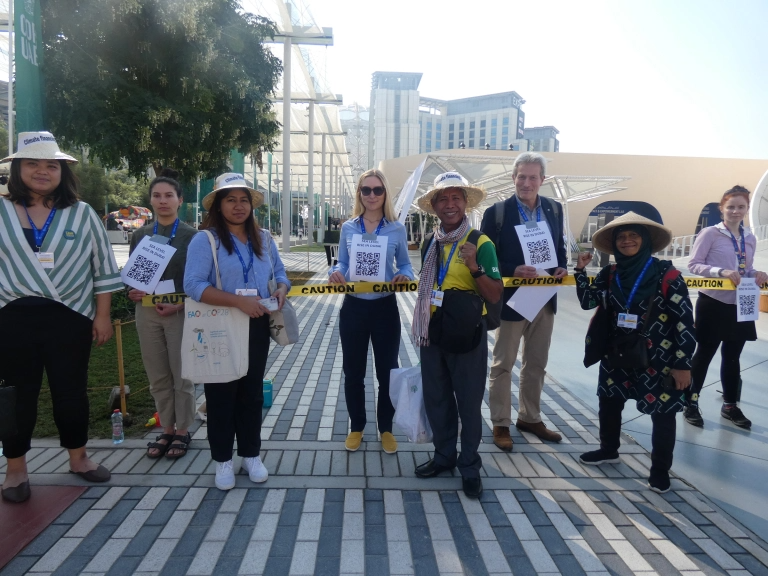
The scientific push was not in vain though, says Pearson:
“The “Call” had a clear impact on getting governments to agree that the next round of pledges (Nationally Determined Contributions, NDCs, due in 2025) should be consistent with 1.5°C “as informed by the latest science”. Earlier, 2°C was still being mentioned as an upper limit.

Tragedy for the planet – dream outcome for fossil fuel industry?
The Guardian quotes a range of scientists, describing the failure of Cop28 to call for a phase-out of fossil fuels as “devastating” and “dangerous” given the urgent need for action to tackle the climate crisis. One called it a “tragedy for the planet and our future” while another said it was the “dream outcome” for the fossil fuel industry, writes Damian Carrington. The scientists quoted said the agreement contained too many loopholes and did not match the severity of the climate emergency.
“In the end, the climate doesn’t care who emits greenhouse gases. There is only one viable path forward, and that is for everybody to phase out almost all fossil fuels as quickly as possible”, is the message of an editorial in Nature.
More than 120 countries pledged to triple the world’s renewable-energy generation capacity by 2030. The editorial sees this commitment as a large step forward, “in part because it focuses on near-term action rather than long-term hope”.
“Political leaders worldwide will face pressure because of entrenched economic interests in their unextracted mineral assets. Fossil-fuel producers, such as the United Arab Emirates and the United States, will need to find other sources of revenue and create different jobs for their citizens. Policymakers must also look for ways to ensure that the burden of a phase out does not fall on the world’s poorest citizens. This is not only the right thing to do, but will also be crucial to prevent political blowback against climate policies,” the authors comment.
They have their own take on 1.5°C:
“In the short term at least, the world is all but certain to overshoot the 1.5 °C goal. But there is nothing special about this threshold: this year’s climate extremes have made it all too clear that there is no truly safe level of warming, and every fraction of a degree matters. The main agenda must be to cut emissions as quickly as possible in an effort to head off expensive and potentially irreversible damage.”
The limitations of COP
There were almost 100,000 delegates registered in Dubai – and plenty more in the additional outer zone. I shudder to think how much emissions we must have caused. Yes, I include myself. I justify it in the interests of a higher good, i.e. an ambitious and actionable result. But based on the outcome, I have a guilty conscience. I certainly did not get anything like the outcome I wanted. In a host city where the air is so polluted, the traffic noise is tremendous, tightly packed skyscrapers, artificial resorts, private beaches… and all built on wealth from fossil fuels, I found my doubts about the whole COP process growing.
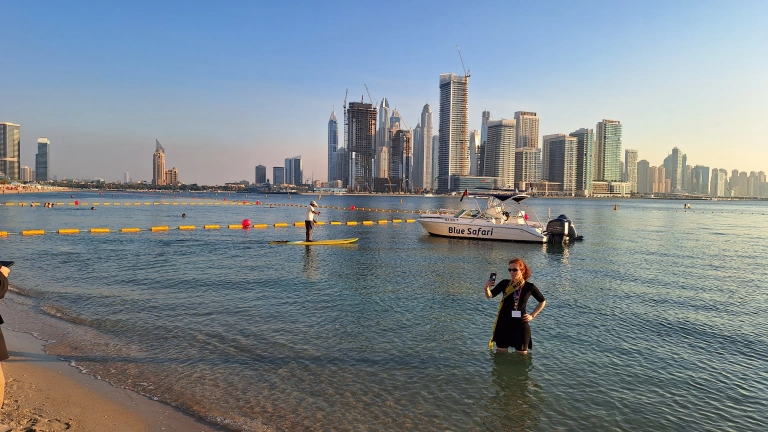
In spite of the whole circus – ultimately, just one country can veto the final decision with dire consequences for the world at large. Countries like Saudi Arabia did just that at the Dubai COP.
Professor Eric Rignot, gave me this blunt reaction:
“The folks in charge of COP28 have a clear agenda. All so clear: Make sure oil companies can keep racking the profits for as long as they possibly can and laugh all the way home from COP28. They win. This entire COP thing is rigged, science is not included, social justice is ignored.”
Lip service has been paid to “fossil fuels”, the “elephant in the room”, being the cause of climate change. But the phasing out has been delayed, the process stalled. Fossil fuel producers have more time to sell more oil and cause more damage – and more time for ice to melt.
Again, Professor Rignot, who has given up going to COP since the notorious Copenhagen event in 2009, which failed to reach a unanimous closing agreement:
“I do not understand why we have to do this dance of compromise when the science points the other way. By doing so, we keep entertaining the idea that the danger is still ahead, in the distant future. It is not. We are already in the middle of it. We also need to point out that there are solutions to the problem, difficult to implement at scale, ok, but solutions exist now; and the discussion should be focused on implementing them across the board now rather than an illusory agreement that yes we should control warming to less than 1.5 deg C, which is akin to voicing a good intent to think about it and gain more time.”

The world can’t wait for the next COP – to be held in Azerbaijan, another oil producing country. Every fraction of a degree of warming matters – every day matters.
High-ambition countries – and those forces in industry and the economy that realise the benefits of the shift to renewables -will have to press ahead. As consumers, conscious of how climate change is altering our world – we will have to make choices and use our influence. Governments have to provide the incentives for that.
The scientists have given us more than enough evidence. The negotiators have not been able to translate that into a timetable of action.
It looks like now it’s up to us.
Related stories from around the North:
Canada: Warming North pushing earth into “uncharted territory”: Arctic Report Card, Eye on the Arctic
Greenland : Blog: Don’t be fooled – we can and we must limit temperature rise to 1.5°C, Irene Quaile
Norway : Assessment looks at dust in Arctic and its impacts on Svalbard, Eye on the Arctic
Russia: Melting permafrost may release industrial pollutants at Arctic sites: study, Eye on the Arctic
United States: Bursting ice dam in Alaska highlights risks of glacial flooding around the globe, The Associated Press

